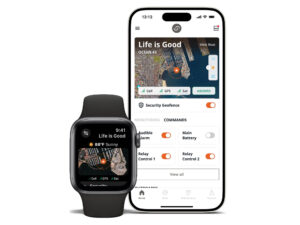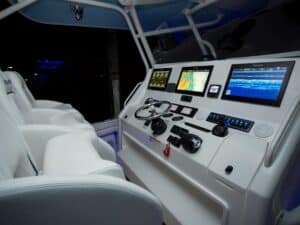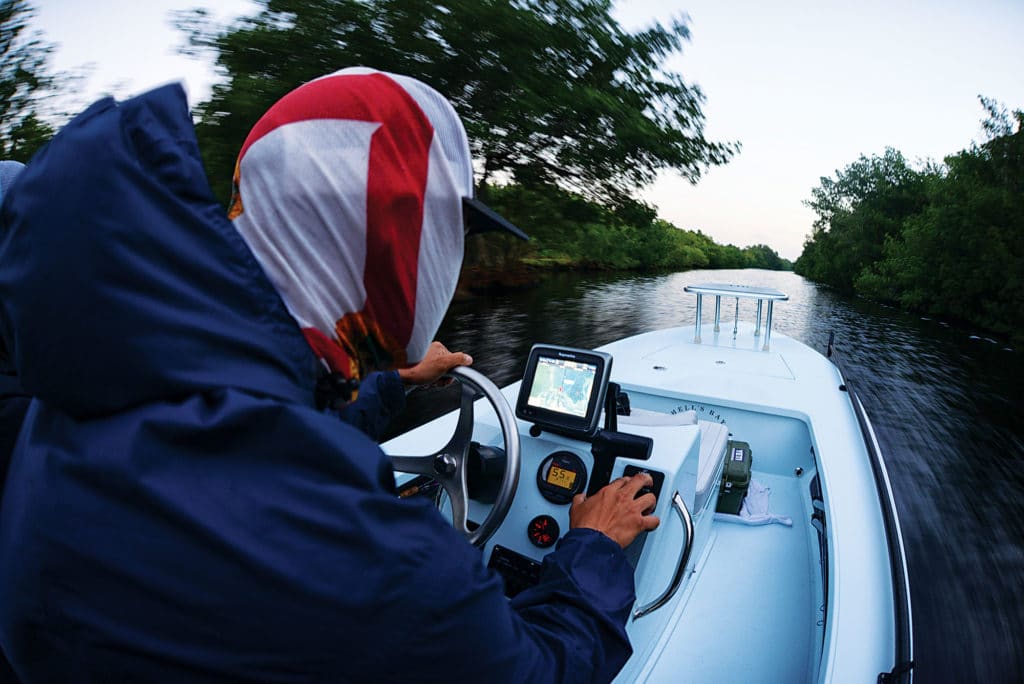
When your bank account flourishes, you shop for marine electronics like a typical enthusiastic American consumer. But when the purse strings tighten, “bargain” becomes your middle name. We hear you. We feel your stress.
Not everyone can afford a state-of-the-art $3,000 multifunction display with all the show-stopping functions and all the fancy networked peripherals. Some of you can, some of you might aspire to that, and one day, many of you probably will afford one, or even two. But when you’re counting every dollar and buying fishing tackle, fuel and boat gear, your electronics must fit your budget.
In the past few years, as prices for consumer electronics and computers have dropped, marine electronics companies have shrunk the size and price tag of some amazingly powerful combo units and multifunction displays. These often smaller offerings obviously appeal to anglers with bay boats, flats skiffs and kayaks, but some of the affordable 7- and 9-inch displays also work for small offshore vessels.
To show you what’s now available for less than $750, I asked the major manufacturers to provide information on these units. I also looked at units from $750 to $1,000, for those who want to push the wallet a tad more.
Furuno
“The cost for all electronic components that make up combo units and MFDs is getting more affordable,” says Jeff Kauzlaric, Furuno advertising and communications manager. “As the computer industry makes advancements in the speed and power of processors and memory, the prices decrease and the marine electronics industry benefits from those developments.”
Furuno sells one combo machine below $750. The GP1670F costs $695 and features a 5.7-inch color display with rotary-knob and button controls. The unit incorporates a chart plotter that runs C-MAP 4D charts and an internal GPS antenna and offers a split‑screen display.
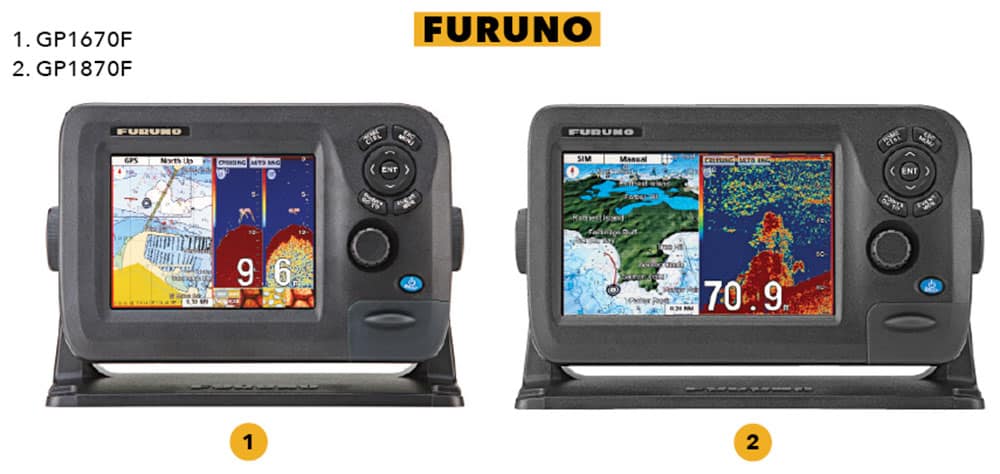
The 600-watt/1-kilowatt fish finder (depending on the transducer) employs Furuno’s Accu-Fish fish-size analyzer and Bottom Discrimination mode, which determines whether the seafloor is mud, sand, gravel or rock. The White Line feature shows fish lying at the bottom. (Furuno transducers start at $70.)
Ticking up a notch, the GP1870F costs $995 and features a 7-inch screen. “The extra screen real estate allows you to view more fish-finder history, which can be critical to monitor the pattern of bait and predator movements,” Kauzlaric says. “With the post-processing gain feature of these units, you can dynamically view changes to the gain setting immediately for all returns on the screen, which is useful especially with this wider display.”
Above the $1,000 mark lie the true multifunction displays, such as the NavNet product line, “which opens up options for adding radar, TruEcho CHIRP, larger displays, RezBoost fish-finder capabilities, multitouch interfaces, app connectivity, and other types of sensor integration and controls,” Kauzlaric says.
Garmin
Two Garmin combo units fall below the $750 barrier: echoMAP CHIRP 44dv ($349.99) and 54dv ($499.99 to $599.99).
Garmin also just introduced its Striker series of fish finders with GPS ($119 to $499 for the 4- to 7-inch units), but the Strikers don’t come with pre-loaded maps, so they’re technically not plotter/sonar combos. (Note: Other units that fit this price range might currently be showing on the Garmin website, but they either come with only a world base map or are being phased out.)
“We think it’s important to offer something for every boat size and every budget,” says Carly Hysell, Garmin media relations manager.
The 44dv comes with a 4.3-inch display while the 54dv features a 5-inch screen; both offer keypad control, coastal charts, and CHIRP traditional sonar (50/77/200 kHz) and DownVü sonar (260/455/800 kHz), as well as Panoptix all-around sonar capability.
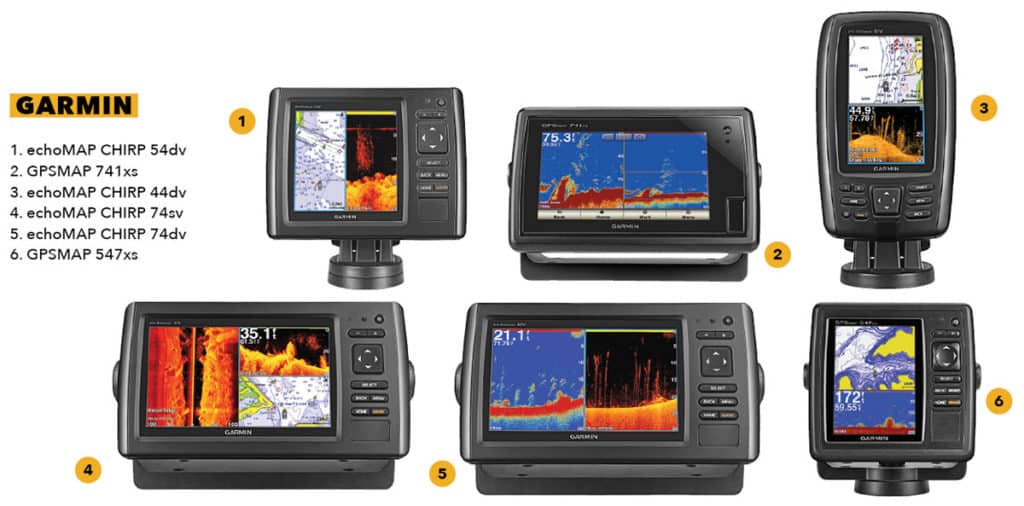
“They also feature New Chart Guarantee, which entitles the user to one free update of the newest chart version,” Hysell says. “All feature built-in GPS, plus Quickdraw Contours, so users can instantly create HD fishing maps on screen with 1-foot contours.”
Four more combo units fill the $750 to $1,000 range, including echoMAP CHIRP 74sv ($849.99) and 74dv ($899.99), and GPSMAP 547xs ($849.99) and 741xs ($999.99). These come with 5- or 7-inch displays, sonar, and coastal charts. Some offer DownVü sonar; some come with a transducer. The 74sv offers both DownVü and SideVü, and the 741xs includes a multitouch touchscreen display.
For units that don’t come packaged with a transducer, Garmin pricing starts at $149.99 for CHIRP transducers.
Combos and multifunction displays costing more than $1,000 add in SideVü, larger screens, and more video capability, Hysell says. “It’s easy to select a Garmin because all have similar features. It just depends on the size of the display and the price point you want to hit,” she adds. “The 7600 series, for instance, includes 7- to 16-inch units, all with very similar features. You just pick a screen size and a budget that fits.”
Humminbird
Six of Humminbird‘s new Helix 5- and 7-inch units ($299.99 to $699.99) and one Helix 9 unit ($699.99) fall beneath the $750 mark. Two more 9-inch Helix machines ($799.99 and $999.99) and one 10-inch unit drop in under the $1,000 tag. (Other Helixes are sonar-only or signature units.)
The Helix 5 Sonar GPS starts the combos at $299.99 and comes with a 5-inch screen, keypad control, DualBeam Plus sonar (dual-frequency-capable), and internal GPS chart plotting with built-in UniMap cartography and a micro SD slot for optional maps or saving waypoints. This basic unit does not support NMEA 2000 networking, so it’s essentially a stand-alone unit.
Other 5-inch Helix combo units include the DI GPS ($349.99), which adds down-imaging sonar, and the SI GPS ($499.99), which adds down- and side-imaging sonar.
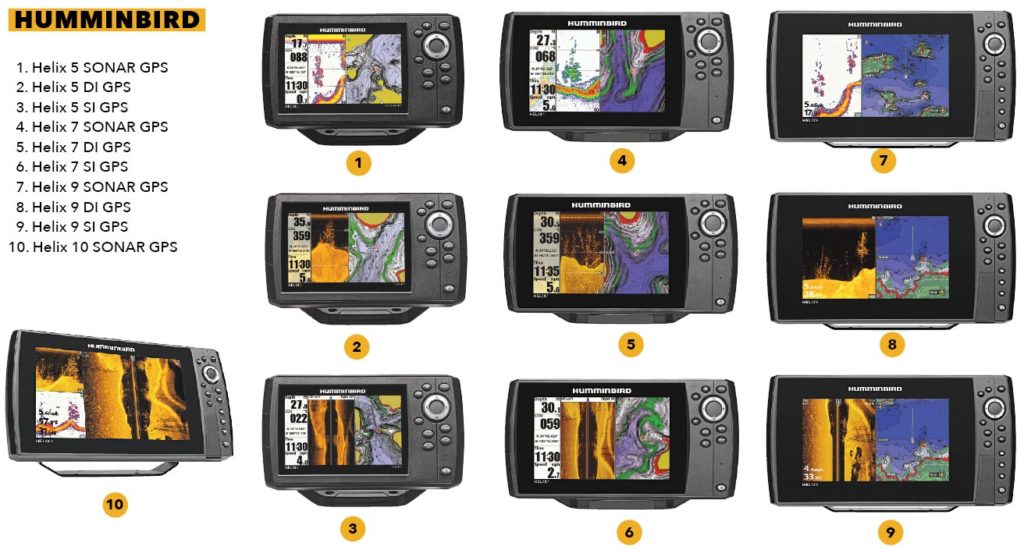
The Helix 7 combo units, featuring a 7-inch display, start at $449.99 and progress in the same fashion as the 5-inch versions. The Helix 9 Sonar GPS, with a 9-inch screen, costs $699.99 and includes GPS chart plotting, traditional 2-D sonar and built-in AutoChart Live, which allows you to map the water as you drive the boat.
Helix 9 DI GPS and Helix 9 SI GPS bridge the $750 to $1,000 gap, bringing in down- and/or side-imaging sonar. For $999.99, the Helix 10 Sonar GPS offers a slightly larger display with traditional plotter/sonar capabilities.
All Helix packages include a transom-mount transducer; additional transducer options start at $150.
Above $1,000, Humminbird offers 10- and 12-inch Helix units, including the Helix 12 CHIRP and the ONIX/ION multifunction displays, with Cross Touch (touchscreen and tactile control), more waypoint capacity and a more robust operating system.
Navico (Simrad/Lowrance)
Lowrance and Simrad are sister brands. Both offer combo units or multifunction displays below $750: Lowrance Hook-4 ($299), Hook-5 ($349) and Hook-7 ($449); and Lowrance Elite-5 Ti ($449) and 7 Ti ($649). Simrad offers GO5 XSE ($419); and GO7 XSE ($599).
“As the market has seen growth in smaller fishing boats, customers have demanded lower-cost products to match their budgets and boating lifestyle,” says Daren Cole, global brand director for Lowrance and Simrad. “Over the last four years, we have seen 5-inch products sell for what a 4-inch product used to sell for … and 9-inch products for 7-inch price points. These customers are looking for similar features as those in higher-end products but are willing to compromise on some performance aspects, such as sonar ranges, charting options, accessories and expandability.”
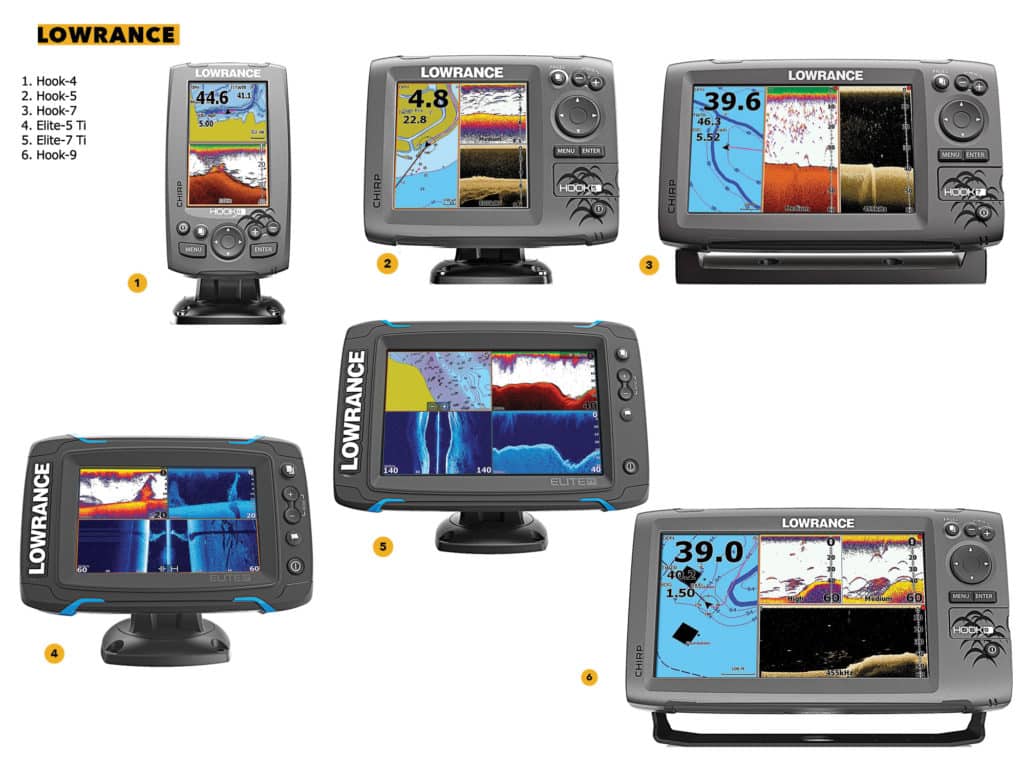
Lowrance 4.3-, 5- and 7-inch Hook units, and 5- and 7-inch Elite Ti units, combine similar fish-finding and chart-plotting features yet offer different control options: keypad control for Hook and touchscreen control for Elite Ti. Both come with basic mapping but are compatible with a variety of add-on chart products. The Elite Ti range of units features an LED-backlit color display, limited NMEA 2000 networking and built-in wireless connectivity.
Hook comes with built-in CHIRP sonar and DownScan imaging, and Elite Ti offers CHIRP, DownScan and StructureScan HD capabilities. Transducers can be packaged with the units at an additional cost.
In the $750 to $1,000 range, Lowrance offers Hook-9 ($949) and the Elite-7 Ti with a Navionics+ chart card and a TotalScan transducer for side- and down-scan imaging and CHIRP ($869).
Under the Simrad GO umbrella, the lower-priced, non-networkable 5- and 7-inch displays come with a multitouch interface and support Insight, Navionics and C-MAP cartography (charts are not included in the price, though separate models are available with cartography). The units also support CHIRP sonar, StructureScan and ForwardScan with the appropriate additional transducers.
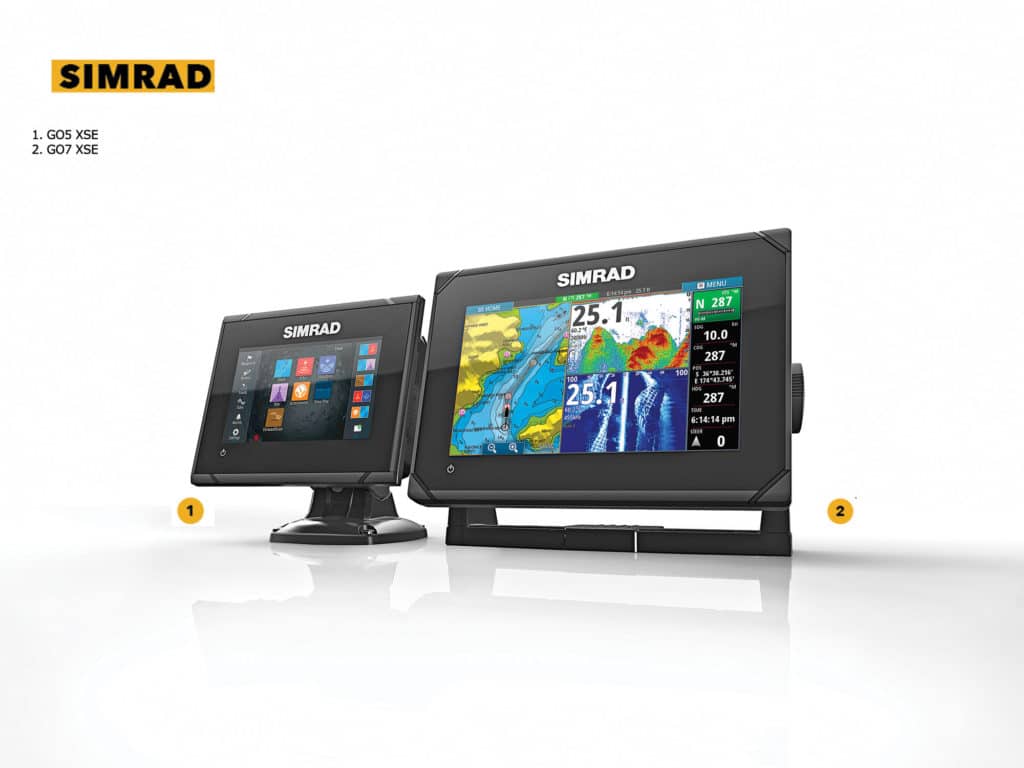
GO5 XSE and GO7 XSE feature an internal 10 Hz GPS receiver, GoFree Wi-Fi capability, full NMEA 2000 connectivity and TripIntel technology, which tracks and displays key information for safe navigation. Both also support SonicHub audio and can act as autopilot control heads.
Simrad NSS, NSE and NSO and Lowrance HDS units start at prices above $1,000. “Typically customers looking to spend more than $1,000 want a product that can do more things, like StructureScan 3D, Outboard Pilot, audio integration and control, radar, and all of the other ‘want it all’ features of [HDS] Gen3,” Cole says.
Raymarine
The launch of Raymarine‘s Dragonfly line “has allowed us to reach a whole new group of customers who might have thought in the past that our technology was either too complicated or beyond their reach,” says Jim McGowan, marketing manager. “We’ve been very successful in showing how industry-leading technology doesn’t just benefit those with big boats and big budgets. There’s plenty of opportunity to bring cutting-edge technology to the small‑boat, small-budget space too.”
McGowan says the Dragonfly units use the same sonar technology that’s available in the company’s higher-end MFDs. The units also feature the same high-brightness and bonded LCD display technology as in bigger, more expensive products.
Dragonfly combo units start at $269.99 with the 4-Pro, which offers a 4-inch screen, CHIRP DownVision, CHIRP fish targeting, GPS (Raymarine LightHouse charts cost $9.99; Pro units are also compatible with Navionics and C-Map), Wi-Fi, app compatibility and a transducer. The 5-Pro, with a 5.7-inch screen, starts at $469.99; the 7-Pro, with a 7-inch screen, starts at $619.99.
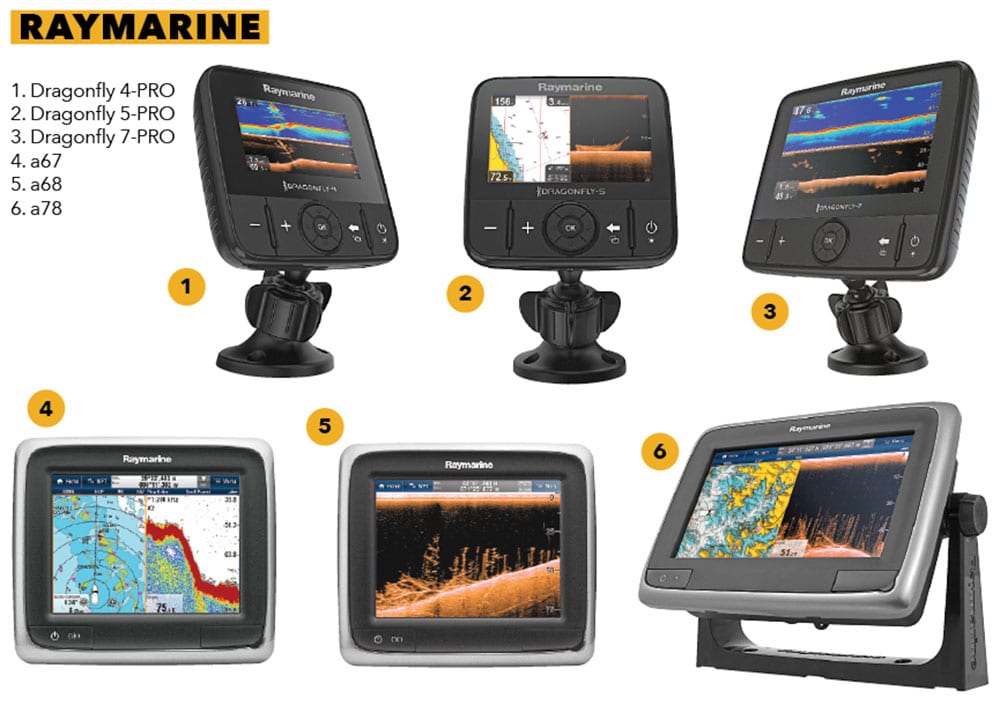
In addition, the aSeries a67 (5.7-inch display) with ClearPulse traditional sonar starts right at $749.99.
Between the $750 and $1,000 cost parameters, networking and advanced accessories start to become options for boating anglers, McGowan says. “The aSeries models run our LightHouse II operating system and feature multitouch controls. Because they are networkable, it’s easy to add more advanced accessories, including CHIRP SideVision, radar, SiriusXM weather and more,” he adds. “Our aSeries line supports NMEA 2000 networking, allowing [the units] to be interfaced to autopilots and other electronics.”
The aSeries combo units in this price range include the a68, a 5.7-inch display starting at $899.99, with CHIRP DownVision, CHIRP fish targeting, GPS, Wi-Fi and a transducer; and the a78, a 7-inch display with all of the above features, starting at $949.99.
MFDs that start at $1,000 feature larger displays of 9, 12 or 16 inches; they add some other capabilities, such as HDMI video output or analog video input. “Otherwise, though, one of the great things about Raymarine’s LightHouse II family of MFDs is that they all have the same major features and capabilities,” McGowan says. “You’re really only limited by what accessories you choose to add to the system.”
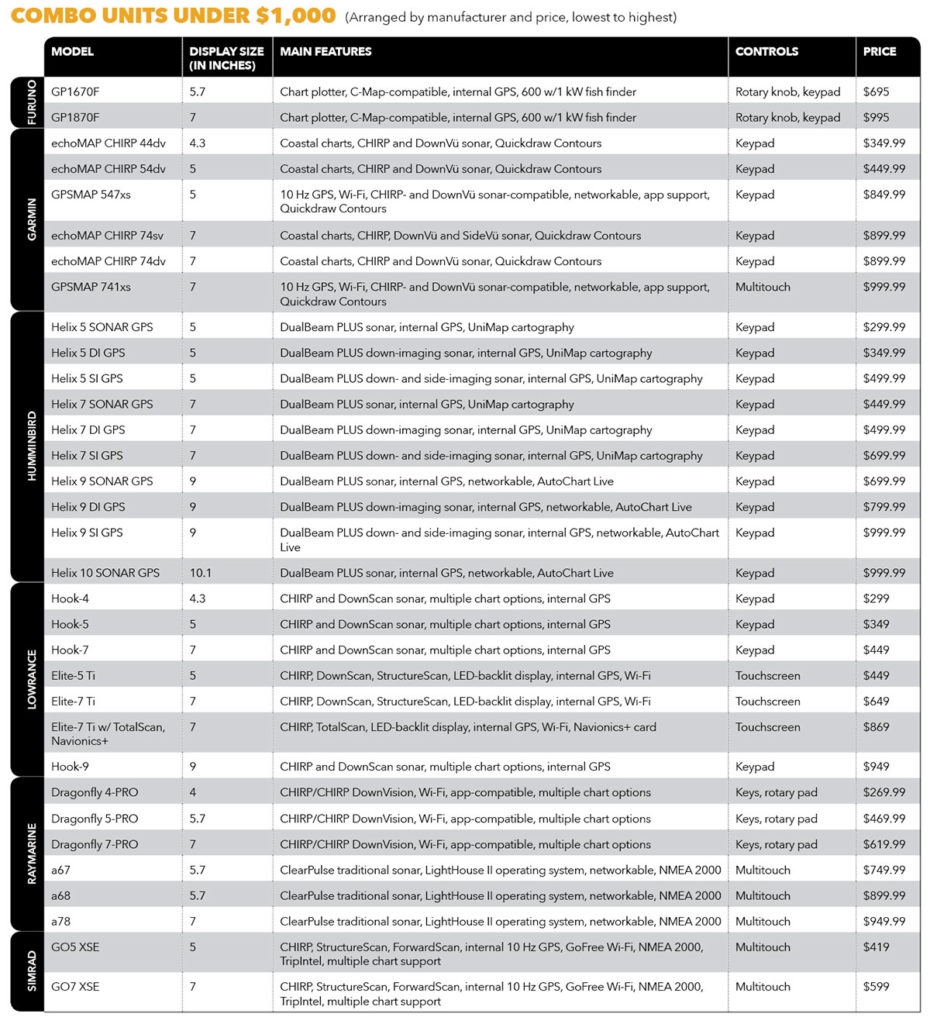
Assessing Choices
When buying new electronics, remember that the purchase price represents only part of the picture. Think about the kinds of fishing you do throughout the year and the kinds of fishing you hope to do in the future. Are you considering tournament competition? How much space do you have at your console? Those details should also drive your buying choice.
When you find a combo unit or MFD that possesses the features you want, check the specifications and parameters. If it has CHIRP, in what frequency range does it operate, and will it read the depths at which you fish?
You might also find you need or want a different transducer than the one packaged with the unit.
Look closely at the embedded charts. Do they cover your fishing areas in the degree of detail you prefer? If not, can you upgrade the charts?
Do you want a touchscreen unit? Is Wi-Fi or app compatibility important to you? Do you need to network two units together or add in satellite weather, radar or an autopilot?
And finally, consider installation and service options. What does your local marine electronics dealer service and/or sell?
Buying marine electronics is like buying any big-ticket item: You earn your peace of mind and satisfaction only when you gather enough information to make a wise decision.



